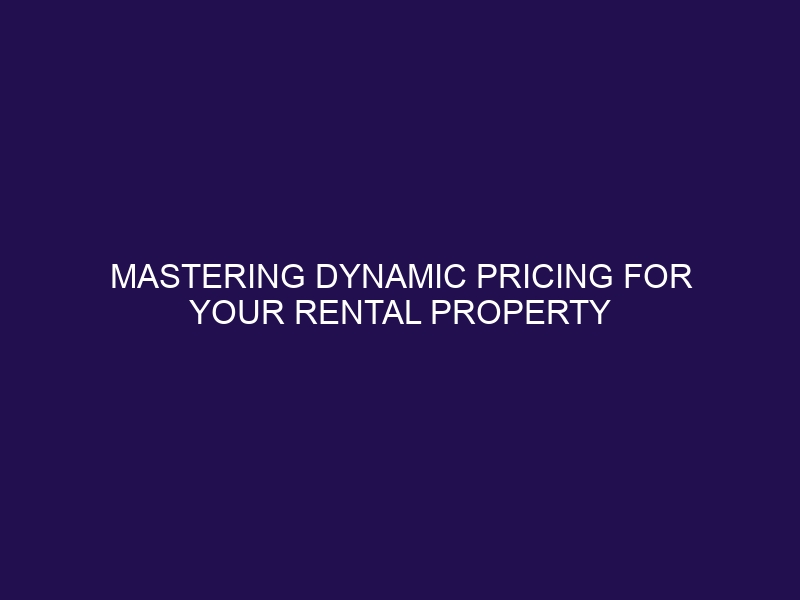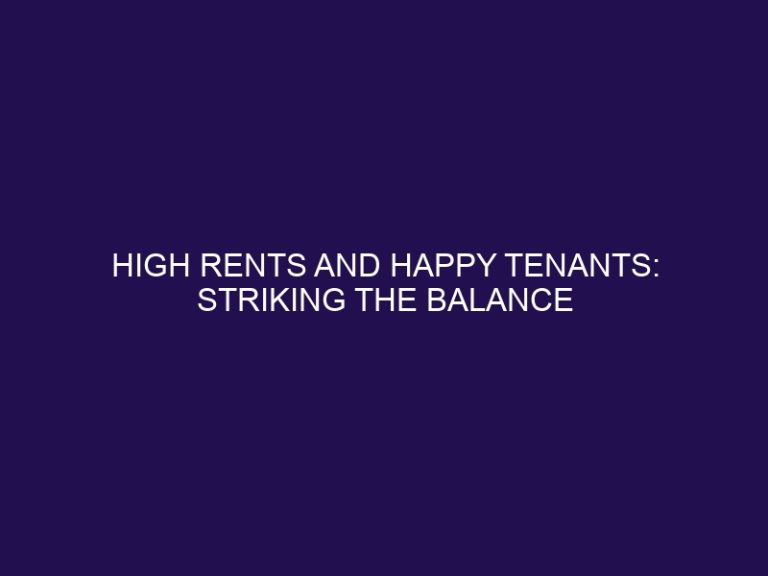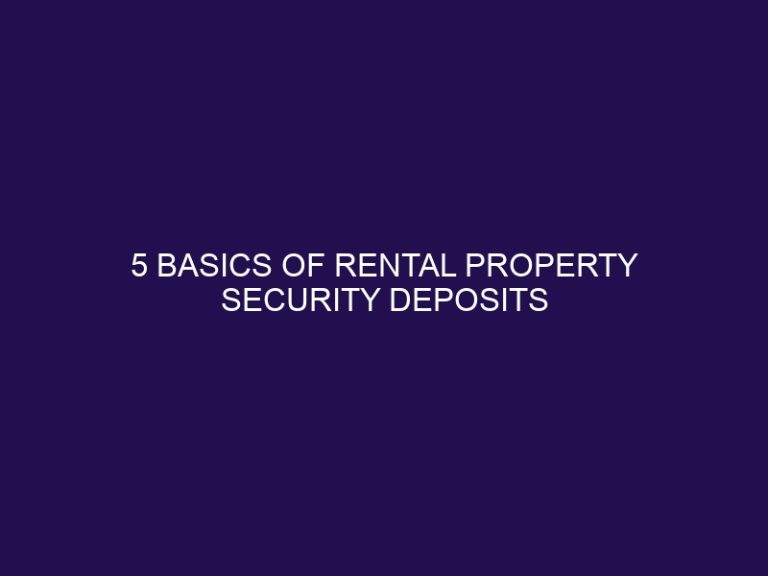Mastering Dynamic Pricing for Your Rental Property
Dynamic pricing, also known as demand-based pricing, is a flexible pricing strategy that adjusts the cost of a product or service based on market demand and other factors. This technique has gained traction in the rental property industry, allowing property owners to maximize their rental income and attract more bookings.
So how does dynamic pricing work for rental properties? It involves constantly monitoring and adjusting rental rates based on various factors such as seasonality, availability, events, and competitor prices.
One of the main benefits of dynamic pricing for rental properties is that it maximizes rental income. This is achieved by adjusting the rental rates to reflect the current market demand, ensuring that the property is always priced competitively. This also leads to increased bookings, as customers are more likely to choose a property that offers the best value for their money. Additionally, dynamic pricing allows rental properties to keep up with market demand, ensuring that they are not over or underpriced.
While dynamic pricing can be highly beneficial, there are also challenges that come with its implementation. One of the main challenges is that it requires constant monitoring and adjustment, which can be time-consuming. It can also be difficult to set up, as it involves analyzing vast amounts of data and setting up pricing algorithms. Furthermore, this pricing strategy may not work for all types of rental properties, as some may have fixed rental rates or may not experience significant fluctuations in demand.
To master dynamic pricing for your rental property, it is crucial to utilize data analytics tools to track market demand, competitor prices, and other factors that may affect pricing. Staying updated on market trends and offering special deals or discounts can also help attract more bookings. However, it is essential to regularly monitor and adjust the rental rates to ensure they remain competitive and maximize rental income. With these strategies, you can effectively implement dynamic pricing for your rental property and see positive results.
What Is Dynamic Pricing?
What Is Dynamic Pricing?
Dynamic pricing is the practice of adjusting rental rates based on market demand, seasonality, and other factors. It involves real-time price changes to optimize revenue. Consider analyzing local events, competitor rates, and booking patterns to implement dynamic pricing effectively.
How Does Dynamic Pricing Work for Rental Properties?
- Dynamic pricing analyzes demand, adjusting rates based on factors like seasonality, local events, and market demand.
- Utilize data-driven tools to set optimal prices, maximizing revenue.
- Regularly monitor competitors’ rates to stay competitive.
- Consider offering discounts for extended stays or last-minute bookings.
When implementing dynamic pricing, be sure to strike a balance between competitiveness and maximizing revenue, catering to diverse guest needs.
What Factors Affect Dynamic Pricing for Rental Properties?
There are several factors that can influence dynamic pricing for rental properties, such as changes in demand, local events, seasonal trends, and the location of the property. Other important considerations include the features, amenities, and competition of the property, which can also play a role in determining pricing strategies.
What Are the Benefits of Dynamic Pricing for Rental Properties?
As a rental property owner, it is crucial to stay competitive in the ever-changing market. One way to do so is by implementing dynamic pricing strategies. In this section, we will discuss the various benefits of dynamic pricing for rental properties. From increasing rental income to attracting more bookings, and keeping up with market demand, dynamic pricing can be a game-changer for your rental business. Let’s take a closer look at each of these benefits and how they can impact your rental property’s success.
1. Maximizes Rental Income
- Optimize pricing to maximize rental income based on demand and seasonal trends
- Utilize pricing tools to set competitive rates
- Offer discounts for extended stays or repeat bookings
2. Attracts More Bookings
- Optimize pricing based on demand fluctuations to attract more bookings.
- Implement tailored pricing for peak seasons or events to increase bookings.
- Utilize dynamic pricing tools to adjust rates in real-time and attract more bookings.
- Offer last-minute discounts to fill vacant slots and attract more bookings.
3. Keeps Up with Market Demand
- Utilize data analytics tools to continuously monitor market demand and adjust pricing accordingly.
- Stay updated on market trends to ensure that pricing is aligned with current demand fluctuations.
- Offer special deals and discounts during off-peak seasons to stimulate demand and maximize occupancy.
- Regularly monitor and adjust pricing based on demand patterns to ensure competitive rates and maximize revenue.
Pro-tip: By effectively leveraging dynamic pricing, property owners can keep up with market demand fluctuations and optimize rental income and occupancy rates.
What Are the Challenges of Implementing Dynamic Pricing for Rental Properties?
While dynamic pricing has become a popular strategy in the rental property industry, it is not without its challenges. In this section, we will discuss the potential difficulties that may arise when implementing dynamic pricing for your rental property. These include the need for constant monitoring, the complexity of setting up a dynamic pricing system, and the limitations of this strategy for certain types of rental properties. By understanding these challenges, you can make informed decisions about whether dynamic pricing is the right approach for your rental property.
1. Requires Constant Monitoring
- Utilize data analytics tools for tracking market fluctuations.
- Stay updated on market trends to adjust pricing effectively.
- Offer special deals and discounts to attract more bookings.
- Regularly monitor and adjust pricing to optimize rental income.
In the 19th century, the telegraph revolutionized communication, enabling rapid transmission of information across long distances. In today’s constantly changing market, it is crucial to stay on top of market trends and adjust pricing accordingly in order to optimize rental income. This requires constant monitoring and the utilization of data analytics tools to track market fluctuations. Additionally, offering special deals and discounts can help attract more bookings and increase revenue.
2. Can Be Difficult to Set Up
- Research Dynamic Pricing Tools
- Understand Property-Specific Factors and the potential difficulties in setting up a dynamic pricing system.
- Seek Professional Assistance if Needed to ensure successful implementation.
3. May Not Work for All Types of Rental Properties
- Assess property type: Dynamic pricing may not be suitable for long-term rentals or properties in remote areas.
- Evaluate target market: Properties catering to budget travelers or extended stays may not reap the benefits of dynamic pricing.
- Consider property uniqueness: Unique or niche properties may not align well with dynamic pricing models.
Pro-tip: Before implementing dynamic pricing, analyze your property’s characteristics and market demand to make effective decisions.
How Can You Master Dynamic Pricing for Your Rental Property?
As a rental property owner, maximizing profits is always a top priority. One effective way to achieve this is through dynamic pricing. But how can you master this pricing strategy for your rental property? In this section, we will discuss four key steps to successfully implementing dynamic pricing. We’ll cover the importance of utilizing data analytics tools, staying informed on market trends, offering special deals and discounts, and consistently monitoring and adjusting your prices. By following these tips, you can maximize your rental income and stay ahead in a competitive market.
1. Use Data Analytics Tools
- Identify reliable data analytics tools for analyzing the rental property market.
- Utilize these tools to analyze demand patterns and competitor pricing.
- Implement pricing strategies based on data-driven insights.
- Regularly assess and adjust pricing using data from analytics tools.
2. Stay Updated on Market Trends
- Subscribe to industry newsletters and blogs to stay updated on market trends.
- Attend real estate conferences and seminars to network and gain insights.
- Use social media platforms to follow industry leaders and organizations for the latest updates.
A property owner who stays up-to-date on market trends and adjusts rental rates accordingly based on seasonal demand has seen increased occupancy and revenue.
3. Offer Special Deals and Discounts
- Create limited-time promotions for longer stays.
- Offer discounts for off-peak booking periods.
- Provide referral discounts for repeat guests.
- Bundle services or amenities with the rental for added value.
4. Monitor and Adjust Regularly
- Use data analytics tools to regularly monitor market trends and make necessary adjustments to rental prices.
- Frequently track occupancy rates and demand to ensure timely adjustments to pricing.
- Provide special deals or discounts during off-peak seasons in order to attract more bookings.
Frequently Asked Questions
What is dynamic pricing and why is it important for vacation rental owners?
Dynamic pricing is a price optimization technique that allows vacation rental owners to adjust their rental rates based on various factors such as market demand, seasonality, and local events. It is crucial for owners to maximize their rental income and stay competitive in a fluctuating market.
How can recreation vacation rentals help owners optimize their rental business?
Recreation Vacation Rentals specializes in vacation rental management and offers comprehensive property management services, including dynamic pricing strategies. They have expertise in the unique challenges and opportunities in the vacation rental market and can provide valuable insights and assistance to owners.
What are the key factors in mastering dynamic pricing for vacation rentals?
Understanding local trends, utilizing dynamic pricing tools, and monitoring property performance are crucial in mastering dynamic pricing. By keeping track of occupancy rates, booking patterns, and guest reviews, owners can make data-driven pricing decisions and ensure a profitable rental business.
How does dynamic pricing work and what factors does it take into account?
Dynamic pricing involves adjusting rental rates in real-time based on market supply and demand, days of the week, lead time, and seasonality. It also considers local events and historical data to determine the most optimal rate for a vacation rental.
Can dynamic pricing help owners stay competitive in a volatile market?
Yes, dynamic pricing can help owners stay competitive by adjusting rates according to changes in market demand. This allows them to attract more guests and maximize their rental income, even in a fluctuating market.
What are the potential risks associated with dynamic pricing?
Setting rates too high or too low can lead to lost bookings or decreased profits for owners. It requires careful consideration and monitoring to avoid these risks and ensure a successful pricing strategy.



![What Is The Empty Homes Tax? [Canada]](https://rentincrease.ca/wp-content/uploads/2023/10/what-is-the-empty-homes-tax-canada_2653-768x576.jpg)



